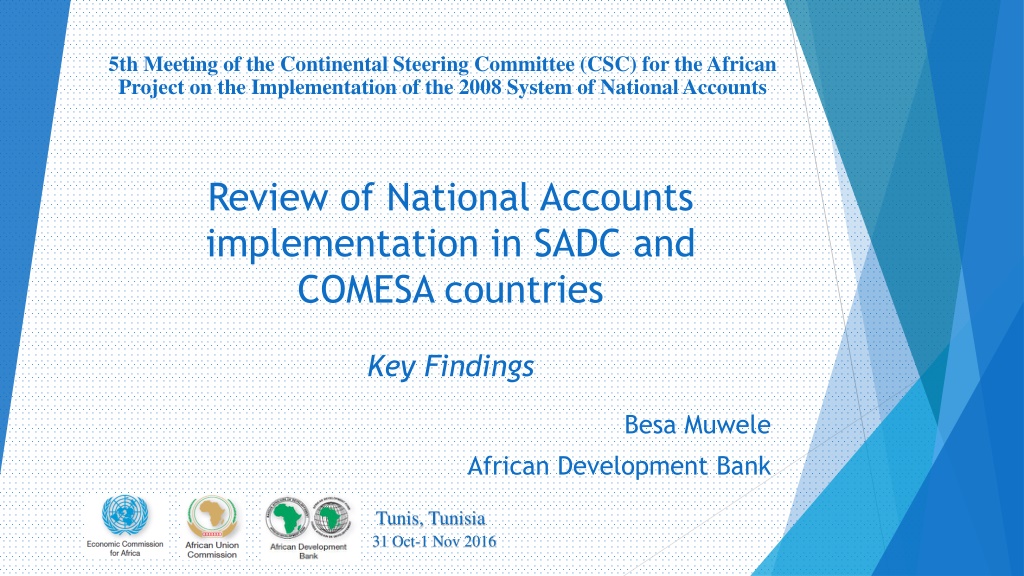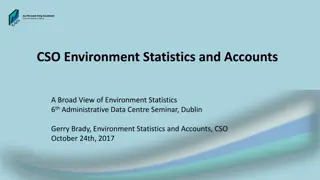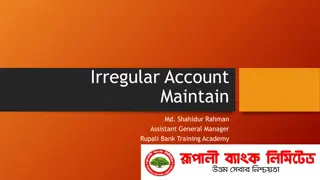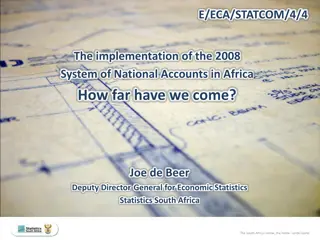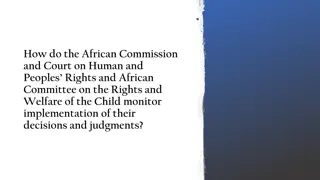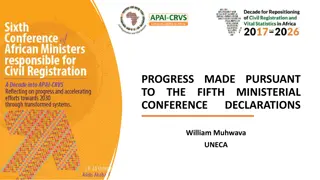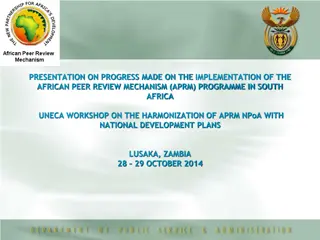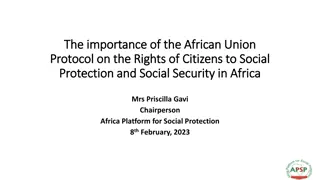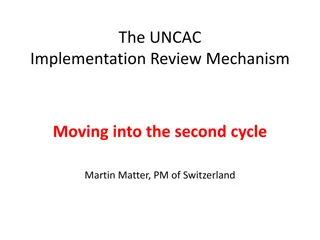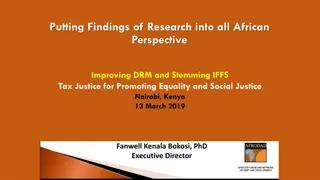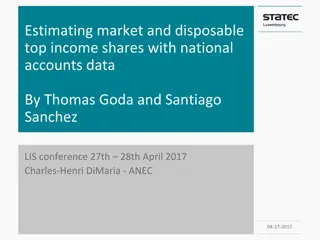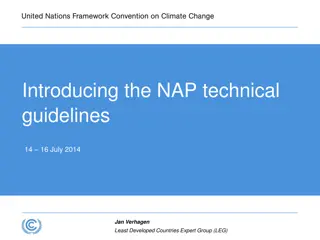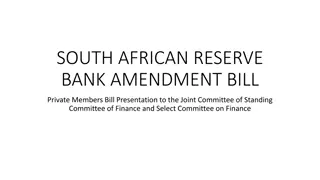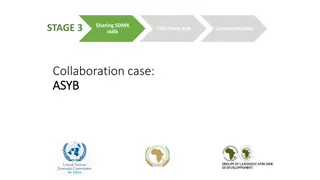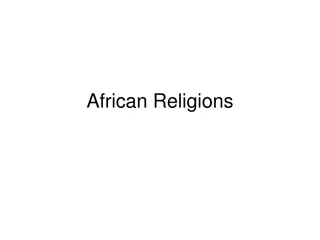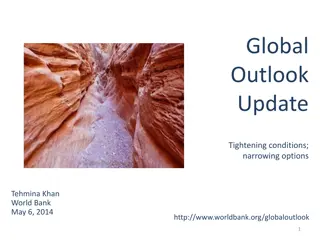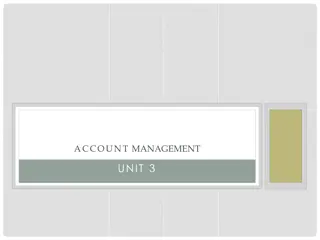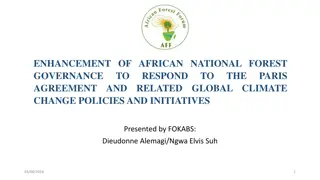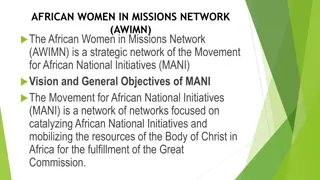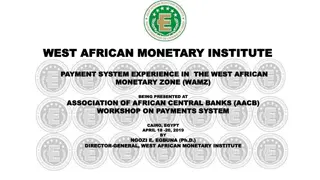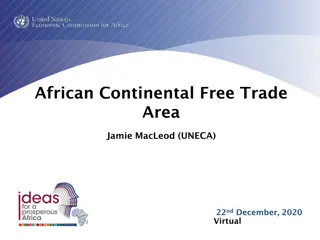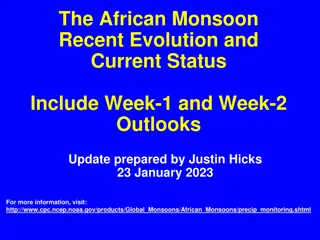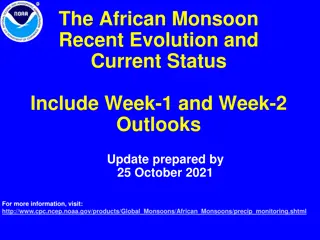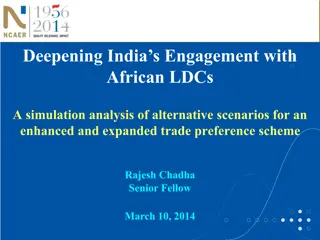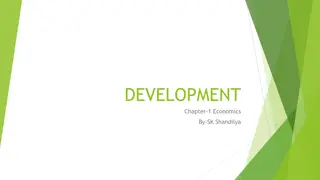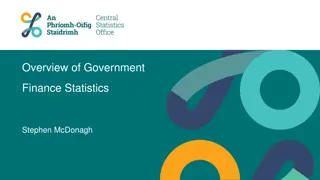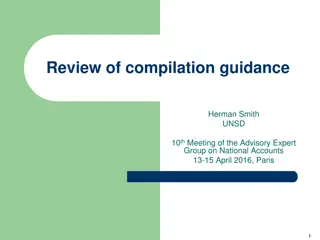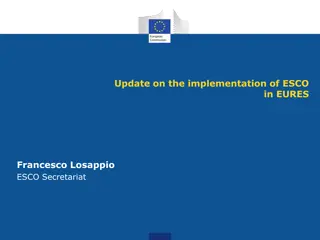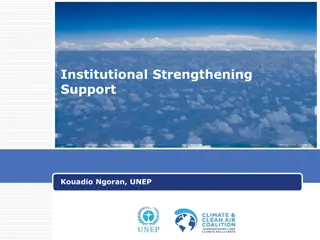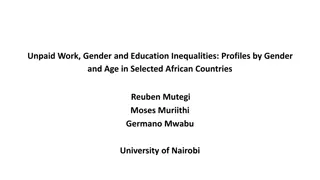Review of National Accounts Implementation in African Countries - Key Findings
Review of the implementation of the 2008 System of National Accounts in SADC and COMESA countries was conducted at the 5th Meeting of the Continental Steering Committee. The assessment covered various aspects such as methodology, staffing, and recommendations. Key findings from the evaluation were presented, along with coverage of countries in the assessment and dimensions for evaluation. The meeting, held in Tunis, Tunisia in October-November 2016, highlighted the progress and challenges in implementing national accounts in the region.
Download Presentation

Please find below an Image/Link to download the presentation.
The content on the website is provided AS IS for your information and personal use only. It may not be sold, licensed, or shared on other websites without obtaining consent from the author. Download presentation by click this link. If you encounter any issues during the download, it is possible that the publisher has removed the file from their server.
E N D
Presentation Transcript
5th Meeting of the Continental Steering Committee (CSC) for the African Project on the Implementation of the 2008 System of National Accounts Review of National Accounts implementation in SADC and COMESA countries Key Findings Besa Muwele African Development Bank Tunis, Tunisia 31 Oct-1 Nov 2016
OUTLINE Background Countries covered in the assessment Dimensions for evaluation of National Accounts Methodology for assessment Staffing of National Accounts Recommendations Tunis, Tunisia 31 Oct-1 Nov 2016 2
Background STATISTICAL BUSINESS REGISTER SNA 2008 IMPLEMENTATION Expert group meeting (2012) Training workshops: Finalization of the guidelines and publication (2013) Development of implementation plans (April 2015 Botswana) Generic System currently operational in Mauritius Compilation of GDP using commodity flow approach (July 2015 Daresalaam) Technical assistance missions conducted in 8 countries mainly in SADC . TA currently going on in Ethiopia Construction of Supply and Use tables (February 2016 Harare) Revision of the guidelines to take into account of international guidelines Methodological Review of Benchmarking, Rebasing and Chain- linking of Economic Indicators (October 2016 Mauritius Study tours conducted by countries to Mauritius including Senegal, Swaziland and Zimbabwe Technical Assistance in NADABAS: Swaziland, Zimbabwe, Botswana and Namibia National Accounts Manual (to be published in first quarter 2017) Tunis, Tunisia 31 Oct-1 Nov 2016
Summary (Non-SADC) COMESA+ report coverage: 14 countries COMESA membership: 19 countries SADC membership: 15 countries Nine (9) COMESA countries covered in this report: Burundi, Comoros, Djibouti, Egypt, Ethiopia, Kenya, Rwanda, Sudan and Uganda. Seven (7) non-COMESA SADC countries: Angola, Botswana, Lesotho, Mozambique, Namibia, South Africa and Tanzania. 9 COMESA countries covered in this report. Eight (8) COMESA countries, which are SADC member states: DR Congo, Madagascar, Malawi, Mauritius, Seychelles, Swaziland, Zambia and Zimbabwe. Two (2) COMESA countries which are not covered in this report due to lack of information: Eritrea and Libya. Eight (8) COMESA countries that are also SADC member states: DR Congo, Madagascar, Malawi, Mauritius, Seychelles, Swaziland, Zambia and Zimbabwe. Four additional African countries that belong neither to COMESA nor SADC: Gambia, Ghana, Liberia, Nigeria and Sierra Leone. Tunis, Tunisia 31 Oct-1 Nov 2016
Methodology of Assessment BASIC scope of national accounts development in terms of the milestone attained, the minimum requirement dataset (MRDS ADDITIONAL The information that is used for the milestones assessment is the data submitted to the United Nations Statistics Division assesses basic economic data that are needed for the development of national accounts response to its Annual National Accounts Questionnaire. These data up to 2013 was published in 2014 by the United Nations qualitative characteristics of national accounts datasets supplemented by recent national publications that can generally be retrievable on government websites adherence to the concepts of the SNA2008 provided to the IMF s on General Dissemination System (GDDS) and Special Data Dissemination Standards (SDDS Tunis, Tunisia 31 Oct-1 Nov 2016
Three dimensions for evaluation of NA 1. Quality adhered closely to the definitions, concepts, methods of estimation and the classification system of the 1993 SNA a national plan for basic statistics (5-10 cycle of census/register and more frequent data) regular programs to collect annual and monthly basic statistics for national accounts purpose. Timeliness: relevance to decision-makers (up to date quarterly, annually). 2. Comprehensiveness in terms of scope (production, distribution and use of income by for total economy and by sectors, financial accounts and balance sheets). 3. Tunis, Tunisia 31 Oct-1 Nov 2016
Three dimensions for evaluation of NA 1. Quality adhered closely to the definitions, concepts, methods of estimation and the classification system of the 1993 SNA a national plan for basic statistics (5-10 cycle of census/register and more frequent data) regular programs to collect annual and monthly basic statistics for national accounts purpose. Timeliness: relevance to decision-makers (up to date quarterly, annually). 2. Comprehensiveness in terms of scope (production, distribution and use of income by for total economy and by sectors, financial accounts and balance sheets). 3. Tunis, Tunisia 31 Oct-1 Nov 2016
UN Milestones Milestones Requirement Milestone 1 GDP in current and constant prices by industries and by final expenditure. Milestone 2 Milestone 1 + GNI (=GDP + net factor income from the rest of the world). Milestone 2 + Value added by institutional sectors + General government sector accounts up to net lending + Rest of the World Accounts (i.e. balance sheet). This means that Gross National Disposable Income (GNDI) is available. Milestone 3 Milestone 4 Milestone 3 + All institutional sectors up to net lending. Milestone 5 Milestone 4 + All institutional sectors up to financial accounts. Tunis, Tunisia 31 Oct-1 Nov 2016
UN minimum requirement data set (MRDS) ) Annual accounts Quarterly accounts Milestone 1 and Milestone 2 Milestone 1 and Milestone 2 Employment by industries Accounts of the total economy up to net lending Accounts of the total economy up to net lending Rest of the world accounts (balance sheet) up to net lending Rest of the world accounts (balance sheet) up to net lending Institutional sector accounts Tunis, Tunisia 31 Oct-1 Nov 2016
Feasibility of compiling the Revised MRDS Feasibility of compiling the Revised MRDS 1. The MRDS set in 2001 includes Milestone 1 and Milestone 2 plus value added by industries. Adoption of SNA2008, in 2011, the standards in MRDS have been raised higher. Employment by industries, all institutional sector accounts up to net lending, and quarterly accounts up to net lending for the total economy and the rest of the world The new MRDS set by the UN Statistical Commission after the adoption of SNA2008, which goes much beyond the MRDS of SNA1993, is simply the criteria adopted by the European Union and the OECD. May not be appropriate for developing countries, particularly with respect to the compilation of all institutional sectors up to net lending as most developing countries, and even some high middle income countries and high income countries (Argentina, Israel, Malaysia, New Zealand, Singapore, Turkey, and all Gulf States countries, etc.) are not able to comply 2. 3. 4. 5. Tunis, Tunisia 31 Oct-1 Nov 2016
Evaluation summary of national accounts implementation (1) Evaluation summary of national accounts implementation (1) COMESA Countries All countries except Comoros. Number Number SADC Countries Areas Annual GDP 16 countries (94%). 7 countries (41%). 15 countries (100%). 7 countries (47%). All countries. Egypt, Kenya, Rwanda and 5 SADC countries: Botswana, Mauritius, Mozambique, and Seychelles. Quarterly GDP Botswana, Mauritius, Mozambique, Namibia, Seychelles, South Africa, and Tanzania. 1countries (6%). Egypt. Minimum Requirement Data Set (MRDS) Subscription to IMF s SDDS Milestones 1 country (7%) South Africa. Egypt and Mauritius. 2 countries (12%). Milestone 4: 2 countries (12%). 2 countries (13%). Milestone 4: 2 countries (13%) Mauritius and South Africa Milestone 0 (1 country): Comoros. Milestone 1 (6 countries): Djibouti, DR Congo, Madagascar, Malawi, Uganda and Zambia. Milestone 2 (6 countries): Burundi, Rwanda, Sudan, Seychelles, Swaziland, and Zimbabwe. Milestone 3 (2 countries): Ethiopia, Kenya. Milestone 4 (2 countries): Egypt, Mauritius. Milestone 1 (7 countries): Angola, Botswana, DR Congo, Madagascar, Malawi, Zambia and Lesotho. Milestone 2 (5 countries): Namibia, Seychelles, Tanzania, Swaziland, and Zimbabwe. Milestone 3 (1 country): Mozambique. Milestone 4 (2 countries): Mauritius and South Africa. Tunis, Tunisia 31 Oct-1 Nov 2016
Evaluation summary of national accounts implementation (2) Evaluation summary of national accounts implementation (2) Number COMESA Countries Egypt, Kenya, Rwanda, Uganda and 4 SADC countries: Lesotho, Madagascar, Malawi and Mauritius Egypt (partially), Kenya, Uganda 1 SADC countries: Malawi (partially). Egypt, Ethiopia, Kenya, Rwanda and Uganda. 4 SADC countries: Malawi, Mauritius, Mozambique and Seychelles. Number SADC Countries Areas Supply and use tables 8 countries (47%) 5 countries (33%) Lesotho, Madagascar, Malawi, Mauritius and South Africa. SNA 2008 4 countries (24%) 2 countries (13%) Malawi (partially) and South Africa ISIC REV4 9 countries (53%) 4 countries (27%) Malawi, Mauritius, Mozambique and Seychelles. Tunis, Tunisia 31 Oct-1 Nov 2016
Basic benchmark data in SADC Census Census of production Alternative to census Administrative data Census of population: All countries implement census of population every 10 years. Census of agriculture: Every 5 years: Swaziland Every 10 years: Botswana, Lesotho, Mauritius. Mozambique, Namibia, South Africa. Ad hoc: Angola, DR Congo, Madagascar, Seychelles, Zambia, Zimbabwe. Business registers of incorporated enterprises (i.e. corporations): Angola, Malawi, Namibia Census survey of agriculture: Tanzania. Seychelles is using financial statements from the Revenue Commission. South Africa (the Reserve Bank) is using administrative data for the financial sector. Economic census Every 5 years: Mauritius, South Africa, Zambia. Informal activities: LFS is carried out Every 5 years: Malawi, Zimbabwe, Zambia Annually, quarterly: Botswana (S/A), Madagascar (A), Mauritius (Q), South Africa (Q) It is unclear how countries estimate annual and quarterly GDP without annual and quarter LFS or even annual household income and expenditure survey. Household income and expenditure survey Every 10 years: Botswana, Namibia, Tanzania. Every 5 years: Malawi, Mauritius, Namibia, Seychelles, South Africa, Swaziland. Tunis, Tunisia 31 Oct-1 Nov 2016
Basic benchmark data in COMESA Census Census of population: Except Eritrea and Comoros, other countries implement census of population every 10 years. Eritrea had the last census in 1984, before independence in 1991. Last census in Comoros:2003. Census of production Census of agriculture: Every 10 years or more: Egypt, Nigeria, Uganda. Ghana: latest 84/85. One is in planning. Ad hoc or as part of census of population: Burundi, Sierra Leone. Alternative to census Business registers of incorporated enterprises (i.e. corporations): Egypt, Uganda. Administrative data Egypt: using data from reports on public enterprises. It is unclear that any other country in the group has a deliberate policy to use data on corporation to compile national accounts. Census survey of agriculture: None. Economic census Varying 5 to 10 years: Egypt, Nigeria, Rwanda Updated registers frequently: Uganda Ad hoc and no census: Ghana, Sierra Leone, Burundi, Eritrea, Liberia and Sudan. Informal activities: LFS is carried out Quarterly: Egypt, Nigeria Every 3-5 years: Ethiopia, Uganda, Ghana (part of household survey). Every 10 years: Kenya. Ad hoc: Liberia, Sierra Leone. Household income and expenditure survey Bi-annually: Nigeria. Every 5 years: Egypt, Ethiopia, Rwanda, Uganda, Sierra Leone. Ad hoc: Burundi, Ghana, Kenya. Tunis, Tunisia 31 Oct-1 Nov 2016
Staffing on National accounts in SADC and COMESA Milestone achieved given professional staff 4.5 4 3.5 3 Milestone achieved 2.5 2 1.5 1 0.5 0 0 5 10 15 Professional staff 20 25 30 35 Tunis, Tunisia 31 Oct-1 Nov 2016
Minimum professional personnel for National Accounts Chief 1 SUT, annual & quarterly national accounts balancing including estimation of GCF, price indexes for nonmarket services 2 Nonfinancial sector/activities Financial activities (banks, insurance, other financial services) 1 1 Government sector (transforming government finance statistics to SNA and estimating quarter and annual data) 2 Foreign trade (transforming trade statistics, BOP to SNA data) 0.5 Tunis, Tunisia 31 Oct-1 Nov 2016 Informal activities Household activities, final consumption Total 0.5 1-2 9-10
Recommendations for improving National Accounts National strategy on improvement of economic statistics and National Accounts A 5-year cycle construction of benchmark national accounts such as the supply and use table and institutional sector accounts For formal enterprises: a 5 year cycle economic census for the incorporated enterprises may be replaced by a thoroughly updated register of business every 5 years and also updated yearly the economic census should be followed by a detailed survey to cover all large corporations and a sample of medium and small enterprises to obtain information for the construction of the Supply and use tables and the full sequence of accounts for the financial and non-financial sectors. Tunis, Tunisia 31 Oct-1 Nov 2016
Recommendations for improving National Accounts Recommendations for improving National Accounts For informal enterprises/activities, employment in the informal sector may be used to estimate this sector on the basis of every 5 year survey of the informal units identified in the population census and then by household survey. For administrative data: it is necessary to produce foreign trade statistics, balance of payments, government finance statistics, banking and insurance statistics at least quarterly, but preferably monthly. Tunis, Tunisia 31 Oct-1 Nov 2016
Recommendations for improving National Accounts Recommendations for improving National Accounts Monthly, quarterly surveys requesting very limited information (sales/revenues, compensation of employees and employment only) to estimate main national accounts aggregates such as quarterly GDP by extrapolating from the benchmark ratios. More elaborate annual economic survey may be needed to affirm the quarterly data. Proto-type questionnaire for the benchmark, annual, quarterly/monthly be developed so as to incorporate all information necessary for the implementation of SNA2008 and the compilation of institutional sector accounts. Tunis, Tunisia 31 Oct-1 Nov 2016
